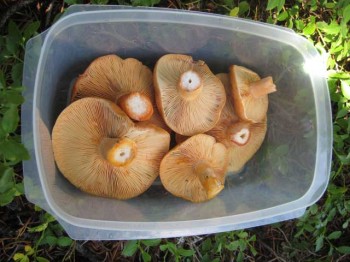
It rained quite a bit a few days ago and now the mushrooms are up again, though we’ve found only one bolete in recent days—a magnificent one, but past its prime so we left it. I wonder if the season for boletes is past?
No biggie. Boletes are good but so are Lactarius deliciosus, a mushroom I had not intended to try because it has gills, but when my friend Butter announced that she was looking for it, I starting looking too—and then found them in abundance.
Delicious Milky Caps
Lactarius deliciosus is just as it sounds: milky and delicious. It’s creamy light orange, both on the cap and gills (which should not be white). Deliciosus is what happens when you sauté it in oil for a while—though just how delicious it is seems subject to debate, with Vera Stucky Evenson (1997) saying, “Although a popular edible in other countries, Colorado’s variety of this species are not always delicious.”
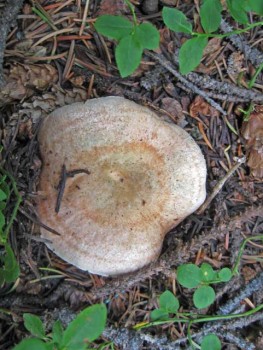
For me, however, Lactarius deliciosus satisfies much of what I seek in a mushroom. It has a pleasing crunch; it browns nicely, exuding a tasty liquid when sautéed; and it’s substantial—it doesn’t cook down too much and complements a dinner nicely.
Evenson says to choose the young and very fresh Lactarius deliciosus (over the old and stale, presumably) for best results. I agree that this makes sense, as the mushroom seems prone to worms and probably should be gathered as soon as possible after it fruits.
I Want to Be a Crock Hunter
“Every summer the Russian and Siberian taiga teems with ‘crock hunters’ gathering mushrooms for salting,” writes David Arora in All That the Rain Promises and More… (1991). I picture these mushroomers when I’m out hunting sometimes, thinking they must really know what they’re doing.
My Polish stepfamily has mushroom-hunting in its roots, as dad used to eat mushrooms that his grandfather Gagi collected and dried in the northeastern U.S. This was after emigrating here and not wanting to pay the price for imported mushrooms from his homeland.
We gathered our first small batch of Lactarius deliciosus from a dark, moist conifer forest on a mountaintop at 11,500 feet, confirming not only that the gills were light orange and the stalk of more mature specimens hollow, but also that the mushroom stained greenish upon cutting, per Evenson’s description in Mushrooms of Colorado and the Southern Rocky Mountains (1997).
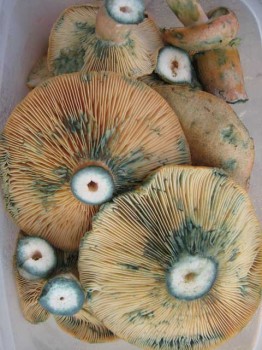
At home, while most of the poor mushrooms sat sadly overnight in the refrigerator turning green, we took the identification a step further with a spore print—for which we removed the stalk, laid the cap gills-down on a white piece of paper, and covered it with a glass for 12 hours—observing that our print was “yellowish buff,” as Evenson said it should be.
(NOTE: This is not an exhaustive species description and should not be taken as such. For that you will need to consult multiple guidebooks, following all safety precautions described therein prior to eating a wild mushroom, especially a “gilly monster,” as Gregg and I like to call mushrooms with gills. You have been warned.)
Milky Cap Taste Test
After 24 hours in the refrigerator, the mushrooms were splotched with green—which was useful in confirming that we had the right ones. We decided to eat them, green and all. After selectively cutting out the wormy parts of the more mature specimens from the hollow stem and attached circle of cap where they seemed to concentrate, discarding some mushrooms in their entirety, we sautéed the remaining pieces on low heat in olive oil, reserving one raw guy in the refrigerator for expert identification should severe gastronomic distress or other symptoms ensue. Later, once we didn’t need the raw and rejected guys anymore, I “planted” them in natural mushroom positions per Evenson in the forest of a similar habitat, hoping they’d release their spores and make Lactarius babies behind our house one day.
As I said, the sautéed Lactarius deliciosus came out crunchy and juicy and nice. Since then we’ve prepared them like that a couple of times, recently adding them to stir fries and such.
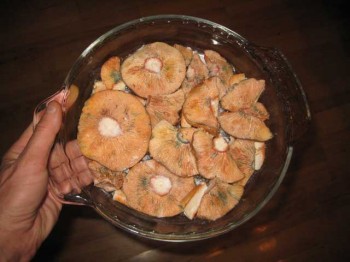
Marinating Mushrooms, Russian Style
I could not envision myself a mushroom hunter in the Russian taiga without preparing some of our finds crock-style, so I attempted to replicate a recipe from Arora’s book. In the process, I learned that I need a real crock with a cover that sits snuggly down inside, something I can use both for salting mushrooms and for lacto-fermentation. Lacking that, however, I ended up making a ridiculous contraption for my first and only milk cap salting experiment.
After cleaning and cutting out the mushrooms’ wormy parts, then, I cut off their stems, laid the caps flat, gills up, in a glass pie dish (Arora says you can do layers, but I didn’t have enough for that), salted them with rock salt, and then covered with a thin aluminum pie dish. I layered on a plastic Tupperware to distribute the weight as best I could and put a big river rock in to weight them down and press out the liquid. Then I left them in the refrigerator for three days to marinate in their own juices. Because I did not get an airtight seal, the mushrooms on the outside edge of the layer turned browner than those in the center, which stayed orange and green with a hint of purple/red and brown. (I ended up consuming both, but the colorful ones in the middle were better.)
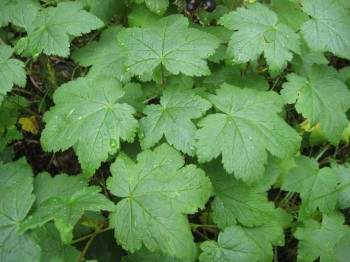
Arora says the Russian and Siberian mushroom salters traditionally use black currant leaves to flavor their layers of Lactarius. Alternatively, he says you can use dill, black pepper, and caraway seeds. For the first three days of my experiment, I used nothing but salt out of laziness. On the fourth day, however, I took off my weighting system and added black pepper, dill, and whole fresh black currant leaves.
The leaves came from a low-lying Ribes plant with big, shiny black berries and no prickers—which I think might be wild northern black currant (Ribes americanum) as described by Kershaw et. al. (1998) but I don’t think is the same as the European variety. Good enough for government work, though, I thought, doctoring my project.
Sipping Vodka with Salted Milk Caps
Right after I added those ingredients, however, I couldn’t help myself any longer. Having heard that in Russia these marinated mushrooms are enjoyed with vodka, I poured myself a small glass of strong, cheap vodka and set about spearing the salted (and now seasoned) shroomies and nibbling on them in between sips of the vile liquid.
I think I must have been making a lot of crazy faces, because Gregg spit out his drink. I couldn’t help myself. The vodka was like rubbing alcohol, and the mushrooms like nothing I’ve ever tasted. I don’t eat a lot of marinated mushrooms in my regular life, you see.
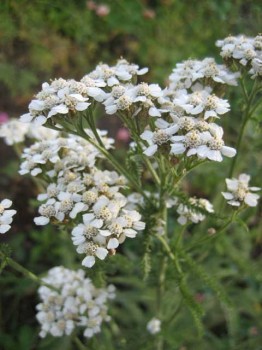
But the combo grew on me, and over the next couple of days I ate those mushrooms as a savory snack to tide me over until dinner, occasionally getting a vodka buzz along with it. No “ill” effects to report!
My good friend and snowboard buddy is a small “jumping frog” of a girl named Olena who is from Ukraine but originally Russia, and we sometimes have great conversations about plants. “You know those small white flowers in a bunch? My grandmother used to make us collect them for medicine,” she told me. Small white flowers in a bunch, what on earth could they be? Luckily, Wikipedia comes in many languages. The plant is yarrow. Of course!
Now I hope to wow Olena with my salted mushroom creation, though honestly I think she was a city girl back home. She’s certainly never given me any reason to believe she’s a mushroom hunter. Still, I hope she emails me back soon. Maybe we can pass some of the shoulder season until the snow falls again rocking out with vodka and funny mushrooms—especially since I couldn’t make it to Burningman this year.
NOTE 2.16.13: Hank Shaw recently posted about salted milk cap mushrooms. He expressed quite a bit of trepidation about lactofermenting them and then eating raw, so he ended up boiling before preparing. I report no ill results but readers may wish to exercise caution with that part of this post.

What a helpful article! I navigated here via other pages on l. deliciosus, which I’ve learned is edible only recently. I do see it around here (Bay Area CA), but have never foraged it … but will now!
JK
Hi, do you know if there is a way to extract the milk from La. De. and making a drink out of it (say, after adding some other ingredients )? Thanks
Interesting idea…but no, sorry. Best of luck with that!